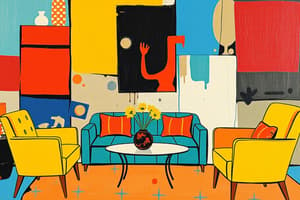Podcast
Questions and Answers
Which factors alongside form are essential in defining design problems according to Peña's framework?
Which factors alongside form are essential in defining design problems according to Peña's framework?
- economy, time, and synthesis
- goals, facts, and function
- analysis, synthesis, and function
- function, economy, and time (correct)
In terms of programmatic design, what are the key components that allow for flexible interior spaces?
In terms of programmatic design, what are the key components that allow for flexible interior spaces?
- flow, hierarchy, and convertibility
- versatility, convertibility, and grouping
- convertibility, expandability, and versatility (correct)
- expandability, hierarchy, and flow
What should be prioritized in a due diligence investigation for residential designs in rural areas?
What should be prioritized in a due diligence investigation for residential designs in rural areas?
- neighborhood character and zoning setbacks
- aesthetic design and landscaping options
- zoning setbacks and septic capacity (correct)
- heating system capacity and septic capacity
What aspect of design problems is analyzed in relation to costs?
What aspect of design problems is analyzed in relation to costs?
Which of the following descriptions best defines convertibility in the context of flexible interior spaces?
Which of the following descriptions best defines convertibility in the context of flexible interior spaces?
Flashcards
Design Problem Factors
Design Problem Factors
According to "Problem Seeking" by William Peña, design problems are expressed in terms of form, function, economy, and time. These factors influence the design process.
Flexibility in Interior Spaces
Flexibility in Interior Spaces
In interior design, flexibility refers to a space's ability to adapt to different needs. It includes convertibility, expandability, and versatility.
Convertibility
Convertibility
A space's ability to be used for different functions through modifications or transformations. It involves changing the layout, furniture, or equipment to suit different purposes.
Expandability
Expandability
Signup and view all the flashcards
Versatility
Versatility
Signup and view all the flashcards
Study Notes
Design Problem Statement
- Design problems can be described using form, function, economy, and time.
- These components can be further divided into more specific categories.
Flexibility in Interior Spaces
- The three key components of flexibility are convertibility, expandability, and versatility.
- Convertibility: Adaptability of the space to different functions.
- Expandability: Ability of the space to adapt and grow through expansion.
- Versatility: Ability of the space to accommodate a variety of activities.
Rural Residential Design Concerns
- The two biggest concerns in a rural area residential design due diligence are zoning setbacks and septic capacity.
Studying That Suits You
Use AI to generate personalized quizzes and flashcards to suit your learning preferences.
Description
Explore the fundamental principles of interior design, focusing on flexibility in residential spaces and the unique challenges associated with rural residential design. Understand key concepts like convertibility, expandability, and versatility, as well as zoning setbacks and septic capacity. Test your knowledge of these important design considerations.




